The history of translation in China,中国翻译史介绍
- 格式:ppt
- 大小:271.00 KB
- 文档页数:13
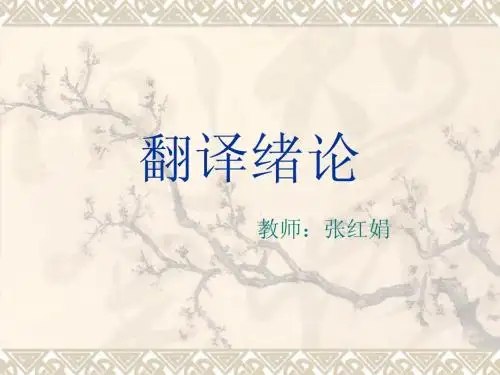
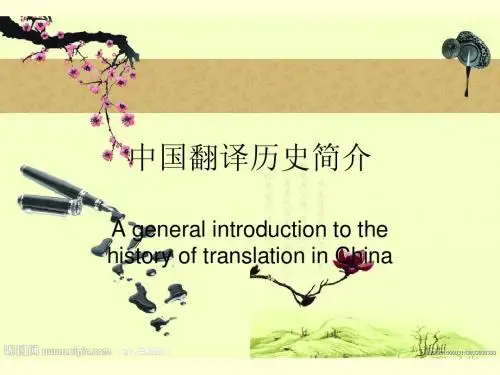
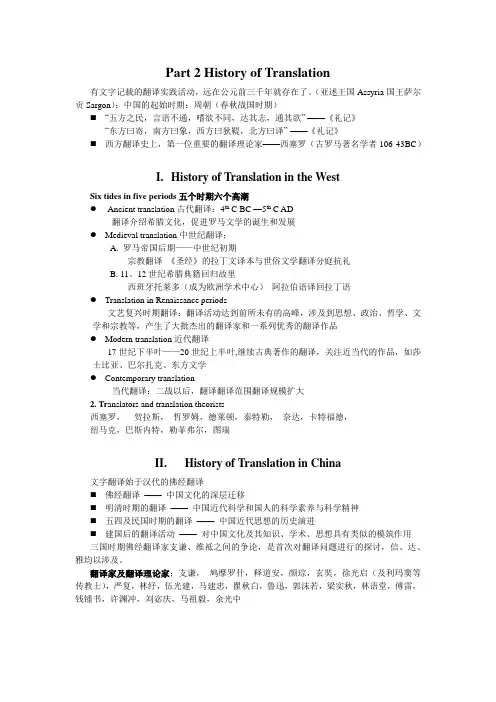
Part 2 History of Translation有文字记载的翻译实践活动,远在公元前三千年就存在了。
(亚述王国Assyria国王萨尔贡Sargon);中国的起始时期:周朝(春秋战国时期)⏹“五方之民,言语不通,嗜欲不同,达其志,通其欲” ——《礼记》“东方曰寄,南方曰象,西方曰狄鞮,北方曰译” ——《礼记》⏹西方翻译史上,第一位重要的翻译理论家——西塞罗(古罗马著名学者106-43BC)I.History of Translation in the WestSix tides in five periods五个时期六个高潮●Ancient translation古代翻译:4th C BC —5th C AD翻译介绍希腊文化,促进罗马文学的诞生和发展●Medieval translation中世纪翻译;A. 罗马帝国后期——中世纪初期宗教翻译《圣经》的拉丁文译本与世俗文学翻译分庭抗礼B. 11、12世纪希腊典籍回归故里西班牙托莱多(成为欧洲学术中心)阿拉伯语译回拉丁语●Translation in Renaissance periods文艺复兴时期翻译:翻译活动达到前所未有的高峰,涉及到思想、政治、哲学、文学和宗教等,产生了大批杰出的翻译家和一系列优秀的翻译作品●Modern translation近代翻译17世纪下半叶——20世纪上半叶,继续古典著作的翻译,关注近当代的作品,如莎士比亚、巴尔扎克、东方文学●Contemporary translation当代翻译:二战以后,翻译翻译范围翻译规模扩大2. Tr anslators and translation theorists西塞罗,贺拉斯,哲罗姆,德莱顿,泰特勒,奈达,卡特福德,纽马克,巴斯内特,勒菲弗尔,图瑞II.History of Translation in China文字翻译始于汉代的佛经翻译⏹佛经翻译——中国文化的深层迁移⏹明清时期的翻译——中国近代科学和国人的科学素养与科学精神⏹五四及民国时期的翻译——中国近代思想的历史演进⏹建国后的翻译活动——对中国文化及其知识、学术、思想具有类似的模筑作用三国时期佛经翻译家支谦、维祗之间的争论,是首次对翻译问题进行的探讨,信、达、雅均以涉及。
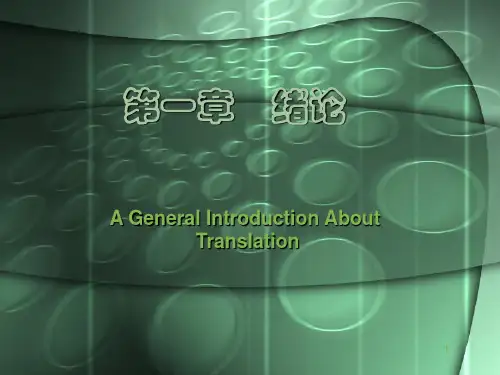
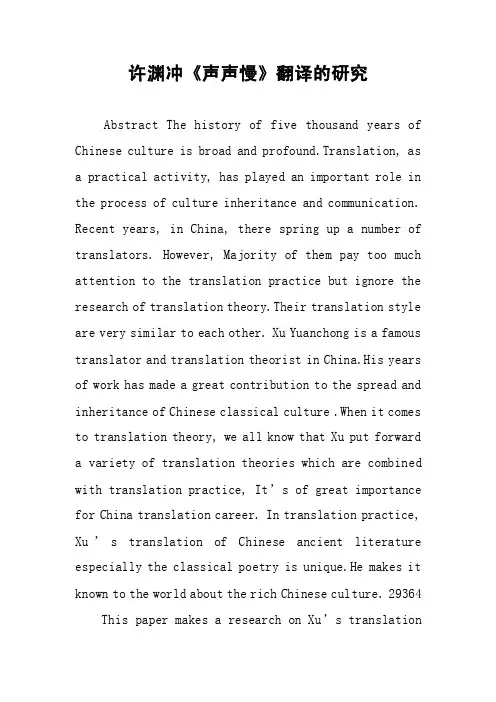
许渊冲《声声慢》翻译的研究Abstract The history of five thousand years of Chinese culture is broad and profound.Translation, as a practical activity, has played an important role in the process of culture inheritance and communication. Recent years, in China, there spring up a number of translators. However, Majority of them pay too much attention to the translation practice but ignore the research of translation theory.Their translation style are very similar to each other. Xu Yuanchong is a famous translator and translation theorist in China.His years of work has made a great contribution to the spread and inheritance of Chinese classical culture .When it comes to translation theory, we all know that Xu put forward a variety of translation theories which are combined with translation practice, It’s of great importance for China translation career. In translation practice, Xu’s translation of Chinese ancient literature especially the classical poetry is unique.He makes it known to the world about the rich Chinese culture. 29364 This paper makes a research on Xu’s translationof Sheng Shengman . And then, I will give a elaboration and meticulous analysis of Xu’s translation thoughts to explore his unique translation style. In addition to the abstract and conclusion, the first chapter of this paper briefly introduces the structure , research purpose, significance etc. And to grasp the works’background, emotion etc.. The second chapter is literature review. I will study the present explore situation of the research and lead you to the original text and Mr Xu to grasp the work background and emotion. The third chapter is theoretical framework. I will study Mr. Xu Yuanchong's translation style according to a certain translation. I will also study his translation thoughts, his theory etc. I will elaborate the theory of Beauty in Three Aspect , the Subjectivity of the translator and the Theory of Teleology that reflected in the translation works. The forth chapter will discuss the translation from the three aspects and look at Xu from the perspective of other people and himself. Then, I will give my own objective evaluation.源自【Key word】:Xu Yuan Chong Sheng Sheng Mantranslation style摘要中华上下五千年历史,文化博大精深。
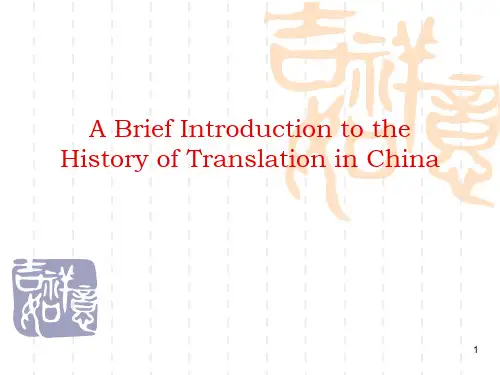


Part 2 History of Translation有文字记载的翻译实践活动,远在公元前三千年就存在了。
(亚述王国Assyria国王萨尔贡Sargon);中国的起始时期:周朝(春秋战国时期)⏹“五方之民,言语不通,嗜欲不同,达其志,通其欲” ——《礼记》“东方曰寄,南方曰象,西方曰狄鞮,北方曰译” ——《礼记》⏹西方翻译史上,第一位重要的翻译理论家——西塞罗(古罗马著名学者106-43BC)I.History of Translation in the WestSix tides in five periods五个时期六个高潮●Ancient translation古代翻译:4th C BC —5th C AD翻译介绍希腊文化,促进罗马文学的诞生和发展●Medieval translation中世纪翻译;A. 罗马帝国后期——中世纪初期宗教翻译《圣经》的拉丁文译本与世俗文学翻译分庭抗礼B. 11、12世纪希腊典籍回归故里西班牙托莱多(成为欧洲学术中心)阿拉伯语译回拉丁语●Translation in Renaissance periods文艺复兴时期翻译:翻译活动达到前所未有的高峰,涉及到思想、政治、哲学、文学和宗教等,产生了大批杰出的翻译家和一系列优秀的翻译作品●Modern translation近代翻译17世纪下半叶——20世纪上半叶,继续古典著作的翻译,关注近当代的作品,如莎士比亚、巴尔扎克、东方文学●Contemporary translation当代翻译:二战以后,翻译翻译范围翻译规模扩大2. Tr anslators and translation theorists西塞罗,贺拉斯,哲罗姆,德莱顿,泰特勒,奈达,卡特福德,纽马克,巴斯内特,勒菲弗尔,图瑞II.History of Translation in China文字翻译始于汉代的佛经翻译⏹佛经翻译——中国文化的深层迁移⏹明清时期的翻译——中国近代科学和国人的科学素养与科学精神⏹五四及民国时期的翻译——中国近代思想的历史演进⏹建国后的翻译活动——对中国文化及其知识、学术、思想具有类似的模筑作用三国时期佛经翻译家支谦、维祗之间的争论,是首次对翻译问题进行的探讨,信、达、雅均以涉及。
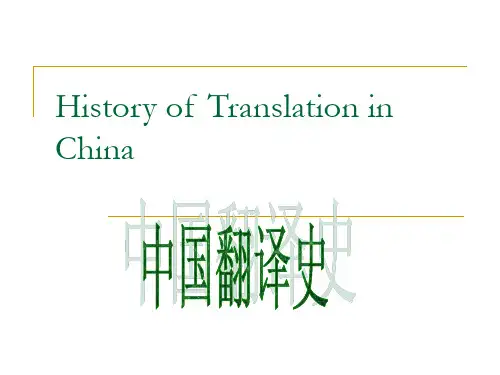
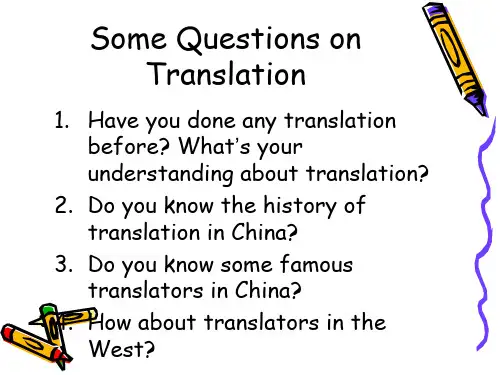
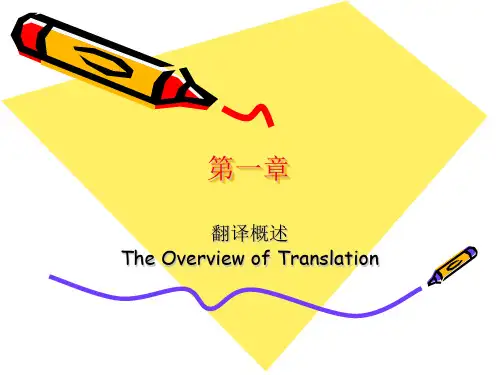
《中国翻译史》课程教学大纲一、教师或教学团队信息二、课程基本信息课程名称(中文):中国翻译史课程名称(英文):A Brief History of Translation in China课程类别:□通识必修课□通识选修课□专业必修课□专业方向课专业拓展课□实践性环节课程性质*:□学术知识性□方法技能性 研究探索性□实践体验性课程代码:04604141周学时:2 总学时:32 学分: 2先修课程:翻译基础授课对象:英语,英语师范三、课程简介本课程为英语及英语师范专业高年级文化通识课程。
以中国历史上的四次主要翻译期(即东汉至唐代的佛经翻译、明清传教士科技翻译、晚清哲社著作翻译、民国文学翻译)为主线,从宗教典籍、知识传播、民族语的形成、文化价值传递等角度,为学生呈现翻译活动丰富的历史面貌。
此外,还选取具有代表性的汉藉外译个案,让学生了解中国名著在国外的译介情况,并赏析部分名著的翻译片段。
课程有助于提升高年级学生文化素养,开阔翻译视界,深化对翻译的理解,同时也可以有效地启发学生思考当下的语言、文化交际及翻译行为与历史的关系。
四、课程目标使学生了解中国翻译史的发展脉络,知道中西文化交流史重大事件和人物,赏析汉译典籍中的名篇名段,以史鉴今,更好地反思当下全球化,职业化时代的语言文化与交际行为。
五、教学内容与进度安排*六、修读要求(满足对应课程标准的第3条)学生务必严于律己,遵守校规,不迟到,不早退,不旷课,特殊情况必须请假说明。
课内学生务必积极思考问题,认真分析问题,主动回答问题。
课内进行各种形式的互动活动。
要求:学生分组选择主题做课堂展示并参与讨论。
每次课后会推荐中西文化交流史相关参考书目,根据个人兴趣选择阅读。
每人至少精读两本,并提交读书报告。
七、学习评价方案(满足对应课程标准的第4、5、6条)1、闭卷考试:70%2、平时成绩:30%10分为出勤,每缺一次扣2分20分为参与presentation、课堂讨论与课外阅读情况。